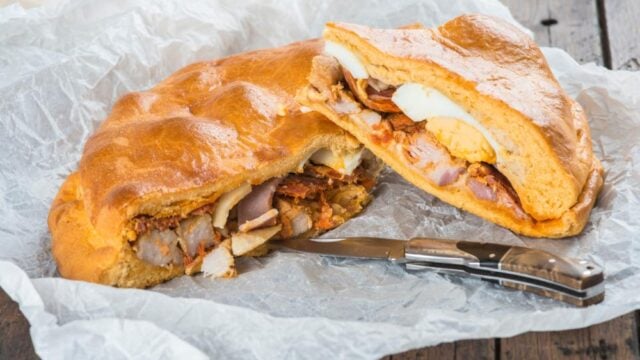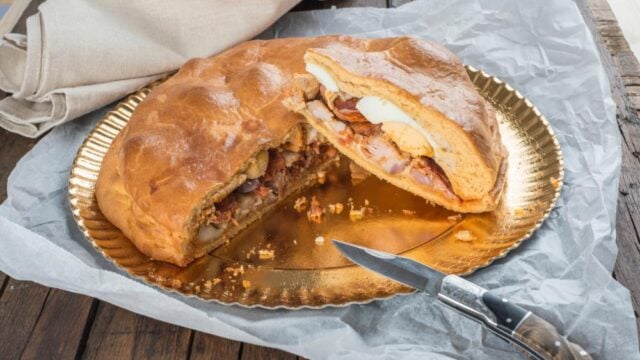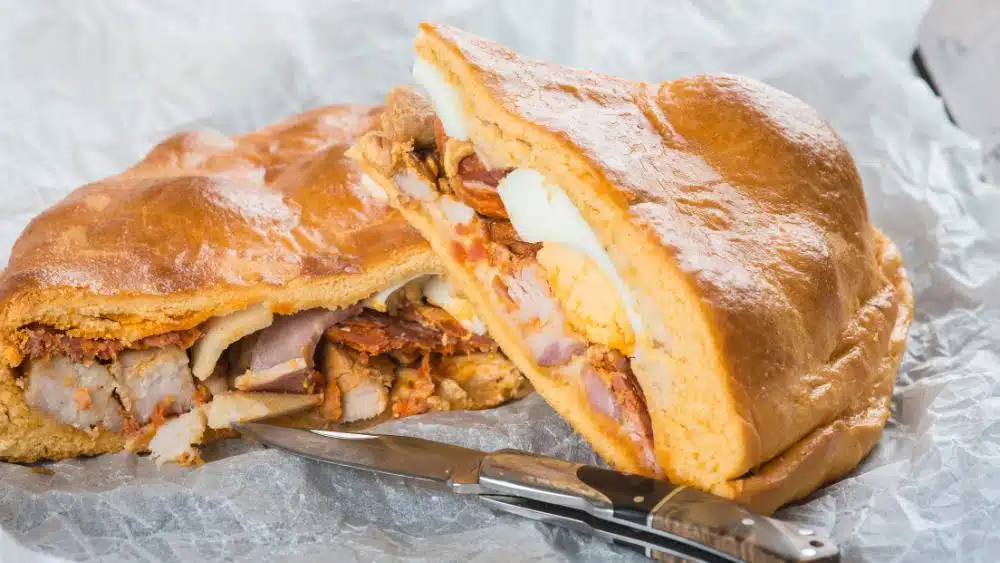Hello everyone, how are you? Here at Paulina Cocina, we embrace the culinary universe that gives us so much satisfaction. This time, we bring you a recipe steeped in history: the Salamanca hornazo .
This delicacy isn't just a simple dish; the classic hornazo is rooted in a strong tradition that spans centuries. In this article, we'll tell you what this tradition entails, as well as share details about how to prepare the Salamanca hornazo and a recipe you can prepare and take to your next picnic!
Content table
About the hornazo
This dish is typical of beautiful Salamanca, in the autonomous community of Castile and León, Spain. The traditional Hornazo is very similar to a Lenten empanada , but loaded with typical local ingredients, such as Serrano ham, chorizo, and pork loin.
The traditional recipe
This is a traditional Spanish dish, which consists of a type of pie or empanada filled with various ingredients, such as chorizo, pork loin, ham, hard-boiled egg , among others.
In Salamanca and other parts of Spain, it is especially popular to consume it during “Lunes de Aguas,” a local festival celebrated on the Monday following Easter Sunday.
- The name “ hornazo ” comes from the fact that in the past, this preparation was made in community ovens, reflecting the importance of coexistence and collaboration in community life.
Origin and traditions
The hornazo de Salamanca is not only a delicious dish from the region's cuisine, but also a cultural and traditional symbol. The celebration of Easter Monday, the Monday after Easter, focuses on picnics, and this empanada is an expression of joy and unity among friends and family.
The tradition of Easter Monday in Salamanca has its roots in the 16th century. It is said that during the reign of Philip II, the king ordered prostitutes to be banished from the city during Lent to maintain the religious atmosphere of the period.
On Easter Sunday, these women returned to the city to resume their activities, which led to an atmosphere of celebration and festivity. On Easter Monday, young students would often go out to the countryside to spend the day, enjoying the fresh air and eating Salamanca hornazo .

The hornazo in its typical setting: Salamanca
The consumption of hornazo and the custom of Easter Monday have endured throughout the years and are still a popular tradition in Salamanca, where it has become a typical festival and a tourist attraction.
The hornazo of Salamanca is a symbol of the festival and is so appreciated by local residents that there is even a street named after it.
Whether in bakeries, pastry shops, or street stalls, this empanada stands out as a symbol of Salamanca's culinary identity.
The process of making the hornazo recipe
The preparation of the hornazo recipe is an art in itself and its preparation is similar to the Galician empanada .
- The carefully prepared dough is rolled out into sheets and filled with a typical mixture of ingredients. It is carefully folded and decorated with beaten egg before baking.
The result is a feast for the senses, with a crispy texture on the outside and a juicy, flavorful filling on the inside.
When and how do you enjoy hornazo?
One of the most deeply rooted traditions surrounding the hornazo de Salamanca is, as we mentioned before, its consumption on "Lunes de Aguas," which occurs the day after Easter. This date marks the end of the dietary restrictions of Lent and is the perfect time to enjoy a succulent culinary feast.
The hornazo takes center stage in this celebration, as its versatility and portability make it an ideal picnic companion. The combination of flavors fits perfectly with this outdoor setting, where the pleasure of food blends with the enjoyment of nature and company.
Tips and advice for preparing hornazo
- If you're using homemade dough, prepare it in advance so it has time to rise and is tender but with a crispy crust.
- Seal the edges of the pastry well to prevent the filling from escaping during baking. Brush it with egg to give it its characteristic golden hue.
- Do not overcook the hard-boiled egg because it continues to cook during baking and can become very dry.
- It's best to eat hornazo the same day it's prepared, but it can also be stored for a few days in an airtight container in a cool, dry place or in the bottom of the refrigerator.
How to prepare the dough
For the dough, we'll mix 500g of wheat flour with a teaspoon of salt, a teaspoon of paprika, and a teaspoon of baking powder. Then, add 100ml of olive oil, 1 egg, and 60ml of white wine, and mix everything together. Gradually, add warm water (about a cup) and form the dough ball.
Then, knead it on a floured surface for about 10 minutes and place it in a container covered with a cloth to rest for at least an hour. Once it has risen, knead it a little more and cut it into two portions, which will be stretched to form the base and top of this empanada.
Follow on Instagram ( here )
and on YouTube that I upload new videos every week ( click here )
Recipe for hornazo from Salamanca
Yields : 6/8 servings
Preparation time : 1 hour
Ingredients
- Empanada dough (see recipe above)
- 200 g of marinated pork loin
- 150 g of Iberian or Candelario chorizo
- 100 g of serrano or raw ham
- 4 hard eggs
- Olive oil
- Beaten egg (to paint the surface)
How to make hornazo step by step
- Preheat the oven to 180°C (350°F). Meanwhile, roll out the dough on a floured surface into two circular pieces. Place one of the rolled-out doughs on a baking sheet. (You can reserve some dough for strips and place them on top of the hornazo, for the typical braided look.)
- Distribute the pork loin, chorizo, Serrano ham, and hard-boiled eggs over the dough.
- Cover with the second layer of dough and seal the edges tightly, forming a pleat. Make a small hole in the center or pierce it with a fork to allow steam to escape during cooking. Brush the surface with beaten egg.
- Bake for 40 minutes or until golden brown and cooked through. Remove from the oven, let cool slightly, and enjoy!






